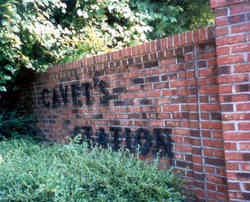Early inhabitants of today’s Concord/Farragut area were the Indigenous Woodland Indians, followed by the Early Mississippians (1000 A.D.) known as the Creek, Choctaw and Chickasaw, and later the Cherokee people.
With the Revolutionary War and the influx of settlers to the area, native residents were hostile to their new neighbors. In return, the settlers held a grudge against them because of the Cherokee allegiance to the British. Under Cherokee Chief John Watts, one Cherokee named Doublehead vowed revenge against the settlers because of the death of his brother, Pumpkin Boy, who was felled at the hands of a sentry during a Cherokee scouting party.

1921 memorial to the defenders of Cavett’s Station
Other factions of the tribe, led by “Old Tassel” and “Hanging Maw,” were more amenable to a peaceful existence. These tribes were the Overhills that lived in what is now Monroe County, present day Tellico Village area.
It was an uneasy time to try to establish any type of residence in this untamed area. For safety, the settlers built block houses, known as stations, to assemble in for protection during Native American attacks. Perhaps the best known was the well-fortified Campbell Station approximately 18 miles west of James White’s Fort.
The small Cavett Station, 8 miles west of Knoxville, sheltered 13 people: Alexander Cavett and family including 2 militia men who had enjoined them for their protection. The location was reportedly at the head of Sinking Creek below the mouth of the Holston. Other accounts state that it was in Grassy Valley in an area along Kingston Pike bounded to the North by Black Oak Ridge.

Cavett’s Station historical marker
Pinpointing the location presents ambiguities. The head of Sinking Creek today is located at Ten Mile Creek, and it meanders down toward the Ebenezer and Blue Grass area. However, another large body of water, also known as Sinking Creek, is located where Concord Marina is today.
In the 1800s, a church named Grassy Valley Presbyterian was in existence where Pleasant Forest Cemetery is today in Farragut along Concord Road. (Not to be confused with modern day Grassy Valley Baptist on Kingston Pike).
Further, the naming of the Tennessee River was not until 1889 by the Tennessee General Assembly. That might explain why early maps depict what is now the Tennessee River as the Holston (or Hogoheegee in Cherokee) or Cootela River (Aboriginal derivative).
On the fateful day of September 25, 1793, a party of Cherokee and Creek warriors were on their way for a surprise attack on the city of Knoxville at James White’s fort. They were aware that a large contingent of troops, headed by John Sevier, were several miles away at Ish Creek Station and would not be there to protect the fort.
It was early in the morning when they heard the customary cannon shot denoting daybreak. Thinking that their plot was discovered, they turned to retreat. Still seeking revenge, Doublehead heard a rooster crow and spied a puff of smoke from Cavett Station, thus averting their planned attack.
The attack offered a ploy when a red-headed half breed by the name of Bob Benge with an excellent command of the English language offered the Cavett family safety if they would surrender. Alas, once they were outside, Doublehead and his party descended on them unmercifully killing every person except a five-year-old child, Alexander Jr. The leader of the party, John Watts, took the child with him but the Creeks later killed the child.
The location of Sevier’s Ish Creek station was reported to be “South of the Holston.” By now, we know that was the Tennessee River. Today’s maps show Ish Creek located in Blount County; however, it empties into what is now Fort Loudon around the Choto/Peters Bluff area. That is the same boundary of 1797 Indian Treaty of Holston. Col. David Campbell wrote that Ish Creek Station was 5 miles from Campbell Station and that Doublehead and his warriors passed within 500 yards of the station on their way to the massacre.

A monument stands at Mars Hill Cemetery denoting the graves of the Cavetts; however, historical accounts report that it is unlikely to be the place of the massacre stating that it was too far from the nearest fresh water source which was a requirement for a settlement.
The late Dr. Charles H. Faulkner, UT professor emeritus, discusses the facts and legends through extensive research in his book “Massacre at Cavett’s Station.” Were he alive today, he could enlighten us further concerning these uncertainties.
For now, one can only assume that the answers are known only to the rooster.
Mona Isbell Smith is a retired computer systems analyst who enjoys freelancing.

